devante jones

Michigan landed transfer G Jaelin Llewellyn out of the transfer portal last week, a move that then sent repercussions across the roster as Frankie Collins decided to exit for the portal himself. Frankie's decision is neither here nor there, and today we will be focusing on Llewellyn himself. A four year player at Princeton who only competed in three seasons (due to the Ivy League canceling athletics for 2020-21), Llewellyn was twice named All-Ivy League for the Tigers.
He attended Virginia Episcopal School to close out his HS days, but Llewellyn is actually Canadian, hailing from Mississauga, Ontario. That gargantuan Toronto suburb may sound familiar to Michigan basketball fans, as it is also the hometown of Nick Stauskas and (Llewellyn's possible teammate) Caleb Houstan. Llewellyn measures 6'2", 175 lbs., not terribly tall, but also a rather skinny frame. For context, DeVante' Jones was listed one inch shorter, but had 25 extra lbs. on Llewellyn.
Another interesting piece of information on Llewellyn before we get really rolling from his HS days is that from a scouting standpoint, he's not your everyday Ivy League recruit. A quick scan at his 247 page from the class of 2018 will tell you that he was actually a solid 4* recruit, landing in the top 100 of the composite (!). He had offers from several P5 schools, including B1G rivals Ohio State and Purdue before committing to Princeton. Finally, I know his name is a bit confusing to look at, but it's pronounced "Lou-well-in". Not super difficult!
STATS
We have to start the stats section by providing a bit of context conference-wise. The Ivy is a decent mid-major conference, and Michigan obviously has some reference with it, having acquired a player out of that league just a couple years ago (Mike Smith and Columbia). KenPom's conference ratings had the Ivy as the 18th-best conference in 2021-22, one spot below the Sun Belt, which produced Michigan's last transfer guard (DeVante' Jones).
Princeton was a good team for a mid-major last season, finishing 23-7 overall and 12-2 in the Ivy, which netted them the regular season crown. From an efficiency standpoint, they were in line with the worst teams in the B1G, like Minnesota. They won their Ivy League semifinal matchup against Cornell but lost the conference tournament title game to Yale by two points, and thus were shipped to the NIT where they lost to VCU. At Princeton, Llewellyn was playing PG, but was both on-ball and off-ball in terms of his role, with a nearly even distribution of possessions split between the two.
The distribution of play types didn't change much at all over his three seasons playing for Princeton. In each one, about 30% of his plays were spot-ups, 20-25% were as the pick-and-roll ball-handler, ~13% were in transition, 5-10% were dribble hand-offs, and ~10% were isolation.
Though the play type distribution didn't change that much between 2019 and 2022, Llewellyn's ability to execute those plays with efficiency did, as he became considerably more efficient as a scorer. As a freshman, Synergy rated his abilities in four of those five play types as bottom quartile in college hoops, with only his transition possessions being considered "average". This past season, however, all but his spot up game were ranked in the upper quartile, and even his spot ups were still 37th percentile, good enough for an "average" rating.
Here are his three seasons at Princeton, with numbers pulled from KenPom:
| USG | ORtg | eFG% | TS% | ARate | TO% | FTRate | FT | 2P | 3P | |
|---|---|---|---|---|---|---|---|---|---|---|
| 2018-19 | 25.1 | 82.0 | 37.9 | 39.4 | 15.2 | 13.7 | 15.2 | 21-37 (56.8%) | 58-153 (37.9%) | 23-91 (25.3%) |
| 2019-20 | 28.7 | 101.5 | 46.0 | 50.6 | 14.7 | 12.5 | 30.9 | 85-109 (78.0%) | 92-200 (46.0%) | 47-153 (30.7%) |
| 2021-22 | 27.5 | 106.6 | 52.7 | 54.1 | 13.1 | 13.1 | 15.2 | 39-56 (69.6%) | 101-206 (49.0%) | 62-162 (38.3%) |
You can see how grisly that freshman season was offensively, a ghastly 2P% and TS% and an ORtg in the gutter despite high usage. His eFG% improved steadily over the years despite the usage not changing all that much, and the big change in his game was the development of that three point shot. His free throw percentage improved some, but not the same consistent slope upwards. The assist rates are not that of a typical point guard, which is how you can see the role Llewellyn played in the offense, working off-ball at a pretty consistent clip.
We shouldn't dip too deep into the defensive metrics, but here's a few:
| DReb% | Stl% | Fouls/40 | DBPM | |
|---|---|---|---|---|
| 2018-19 | 8.2 | 1.0 | 2.0 | -0.8 |
| 2019-20 | 13.0 | 1.8 | 1.6 | -1.5 |
| 2021-22 | 11.3 | 1.2 | 1.9 | -2.3 |
Llewellyn is a decent defensive rebounder for a point guard. He doesn't produce a ton of steals, but his big talent among these stats are his ability to stay out of foul trouble. His fouls/40 clip was top 200 in college basketball all three seasons. The DBPM numbers are not good, and while it's pertinent to point out that Princeton was a bad defensive team (250th in defensive efficiency), Llewellyn's DBPM is worse than that of some of his fellow starters. That said, those sorts of stats often paint inconclusive pictures of a player's ability.
[AFTER THE JUMP: Some video and takes]
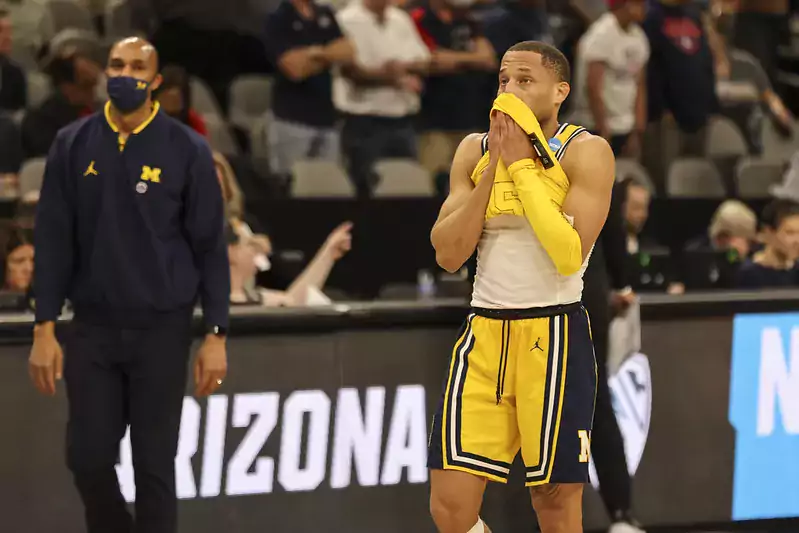
3/24/2022 – Michigan 55, Villanova 63 – 19-15, 11-9 Big Ten, Season Over
This is not going to be a romantic post about the end of a season. Last year, yes, romance abounds. This year it's time to say good job making the best out of a bad situation and start speculating about the future. Because, well, sometimes the bear eats you:
Tonight was Michigan's worst 2-point field-goal percentage (34.9 percent) since Feb. 4, 2020 in a loss to Ohio State. Michigan played 70 games between the two performances.
— Zach Shaw (@_ZachShaw) March 25, 2022
The other stat floating around out there was Michigan going 12/29 on dunks and layups. This kind of thing has happened before, but for it to happen against a team with no real shotblocking (and to a team that was 28th in shooting at the rim nationally) is boggling. Much like the early going of the Colorado State game, it felt like every weighted coin flip came out the wrong way. Michigan would put up a shot that rolled around on the rim and faded out; Villanova would do the same and the ball would eventually decide to go in.
There are other things you can point to, of course—a silly foul by Dickinson at the end of the first half that blunted momentum, an inexplicable no call when Devante' Jones got obliterated, a banked-in three—but while those are all factors the lingering bad taste in everyone's mouth will always be about a bunch of bunnies that did not go down.
At least this feels like a spiritually appropriate way to end the season? I included a Shot Quality graph in the preview that indicated Michigan got a ton of open threes and gave up relatively few, and here's a bookend for that:
Some of that is trying to check Johnny Davis with Eli Brooks because you don't have any 6'5" guys but some of that is just shrug-worthy. Michigan finished the season as a 7th percentile team defending pull-ups, and this was an improvement from that point midseason when they were 1st percentile. The whole damn season was getting good shots and losing to bad shots.
Maybe "bad" should get scare quotes in the previous sentence, because this season forces you to reconsider previous fatwas against mid-range jumpers and the role of athleticism in contesting shots. Since you can get a pull-up on just about every possession having an opposition floor that high is devastating, particularly when you're still in the deep 300s when it comes to forcing turnovers. On the other hand, that hideous performance on pull-ups is 0.9 PPP, ie, still not great. Michigan is getting teams to shoot from the right places; they just needed to have a legion of 6'5"-6'9" NBA wing types to maximize their results. Like, you know, last year.
In the end this was a team with significant flaws we glossed over because of the expectation Caleb Houstan would play like a top 10 overall prospect. This was wrong not only because Houstan played like a typical freshman but because it ignored that we weren't just replacing Isaiah Livers but also Franz Wagner and Chaundee Brown. Those guys got replaced by nothing resembling an NBA wing, and since the schedule was stacked back to front with productive wing types the defense went off a cliff.
Even so they improved over the course of the year, battled through the third-toughest schedule in America, made the tourney, made the Sweet 16, and set the table for next season, give or take a lot of knife-edge NBA decisions. Michigan got great shots and forced bad ones, further confirming that Juwan Howard is "that dude," as the children say. Hit the portal and acquire the most Chaundee-like thing you can find and further success beckons.
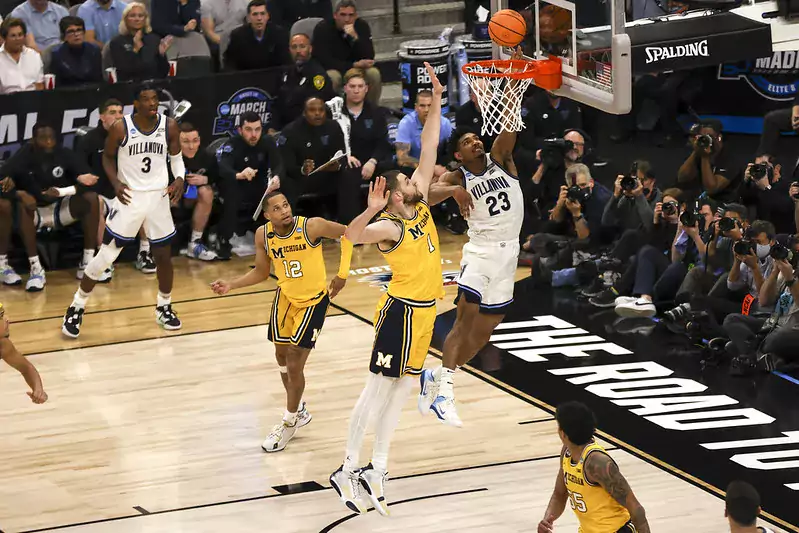
When you enter a game in which your team has a size advantage, especially at the center position, you expect to dominate at the rim. That was the thought entering Thursday night's game in San Antonio for Michigan against Villanova, where the Wolverines hoped to own the paint agains the hot shooting, five-out Wildcats. Michigan had no such advantage, as a team-wide malaise on finishing at the rim doomed the Wolverines despite a strong defensive performance against Villanova. The Wolverines hung tight for much of the contest, but couldn't buy a made layup or free throw when it mattered and in the process, fell 63-55 in the Sweet 16 of the NCAA Tournament. With that, it's curtains on the 2021-22 Michigan Men's Basketball season.
The game got off to a quick start before slowing down dramatically. There were 19 points scored between the two teams just over 5.5 minutes in, with each team trading early scores. Caleb Houstan made an early three that seemed to bode well for Michgian's shooting, but it did not hold up moving forward. Villanova pulled ahead to an 18-11 lead with 10:32 to go in the first and Juwan Howard called a timeout, seemingly furious at Brandon Johns Jr. for a defensive mistake. After that point, Michigan would lock Villanova down defensively, allowing only 13 points the remainder of the first half. Johns himself would turn it around defensively, playing some of the best defense of his career in the latter section of the first half.
Michigan reclaimed the lead 22-20 with just under 4 minutes left in the half after a quick DeVante' Jones-led spurt, including a coast-to-coast layup and then a three pointer. Jay Wright called timeout and got his own 5-0 spurt from star Jermaine Samuels to restore the 'Nova lead, who converted an and-one that tacked Hunter Dickinson with a crucial second foul at the 3:42 remaining mark. The teams each made a couple buckets in the final two minutes and the half ended 31-28 Villanova. Michigan's scoring was evenly distributed between players in the first half, and the Wolverines shot 44% from the floor and 43% from three. The issue were the appalling 1/6 from the free throw line, as well as several missed layups. It felt like Michigan should have led at halftime, given the excellent defense they had played.
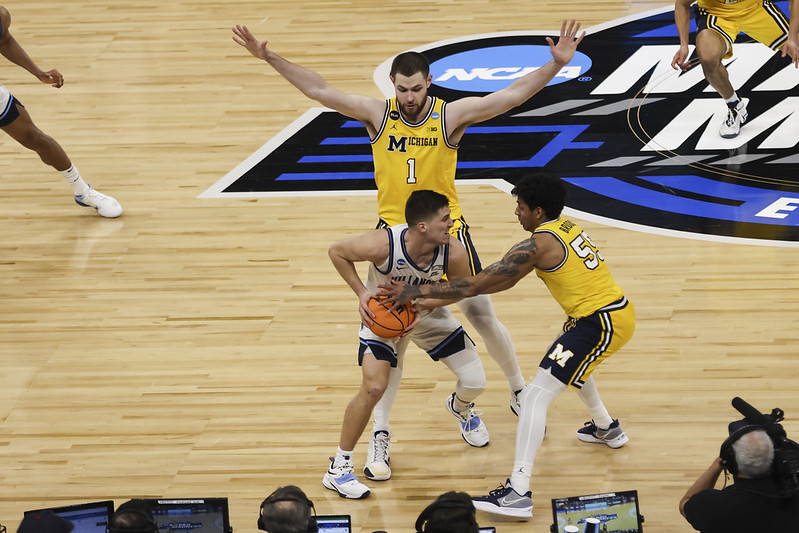
[Patrick Barron]
The second half didn't represent a marked change from the slog of the first half. The Wolverines scored just three points in the first seven-and-a-half minutes of the second half (!), continuing to struggle at the rim and with free throws, in addition to a few sloppy turnovers. The balls clanged off the iron time and time again, as precious time dwindled off the clock. The defense held strong to keep the game competitive, but after Eric Dixon knocked down a three to make it 40-31 Villanova, Michigan was in a pinch.
Eli Brooks stepped up in that pinch, breaking Michigan's offense out of the funk temporarily, nailing a couple threes that cut the game to a six point edge (a Justin Moore three sandwiched in between). The score was 47-41 in favor of the Wildcats with little more than eight minutes remaining when a Collin Gillespie three came up a little short. The rebound kicked out and DeVante' Jones leapt for it, colliding with a Wildcat in what seemed like an obvious foul call. No whistle came, Villanova retained possession, and seconds later, it led to a Caleb Daniels and-one off a touch foul from Moussa Diabate. Daniels swished the free throw and it was 50-41 with 7:52 left.
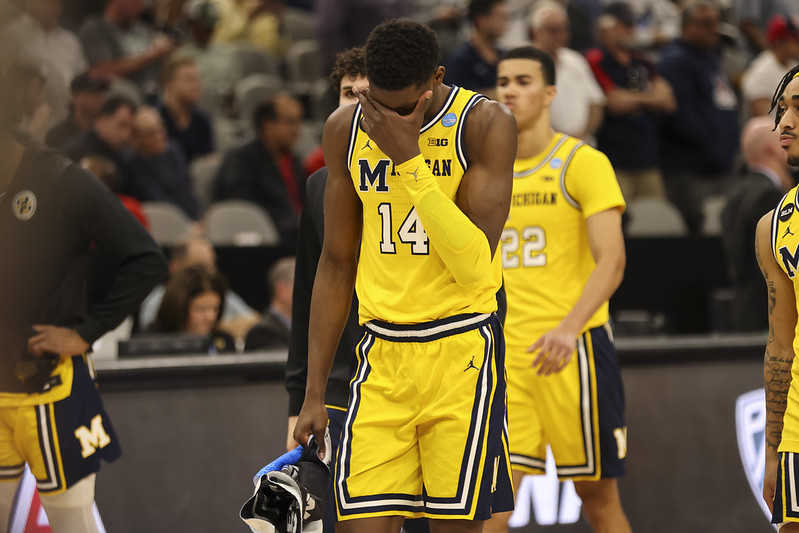
[Patrick Barron]
Villanova's passing over this period of the game was extremely impressive, it should be noted. They moved the ball very well, exploiting Michigan defenders who had gotten out of position, finding the open guy and leading to buckets. That allowed Villanova to convert some key makes to retain a mid-size lead, even as Michigan's offense began to come back on line. When Eli Brooks nailed a three to cut the lead back to six (54-48), there were under four minutes to go in the game.
Michigan needed to make a run, and they began to put a push together. Brooks was hammered on a moving screen, and Terrance Williams II was hacked on the ensuing Michigan possession. T-Will made both free throws and after a 'Nova miss from three, Williams pulled up on a heat-check look from distance that would've cut it to one. The three was well off the mark, and that's the closest Michigan would come to making a comeback.
Jermaine Samuels toasted Hunter Dickinson for a layup and Dickinson would miss one on the other end. At that point, it was getting dark for Michigan and the dagger came only moments later. Collin Gillespie got an open look from beyond the arc and canned a three. 59-50 Villanova, 1:49 left to play. The final 109 seconds of Michigan's season slipped away like sand in an hourglass and the final score read 63-55 in favor of the Wildcats. Game over, season over.
[Click the JUMP for takes]

DeVante Jones Abuses Ohio State in Ballscreen Action
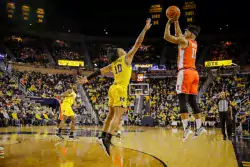
Personnel Problems In The Backcourt

Don't let your opponent shoot 70% from two

Weekly Hoops Trends

The kids are alright (tonight)
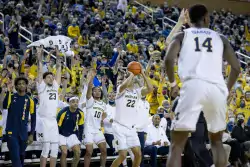
In-Depth Look at Michigan's Shot Quality
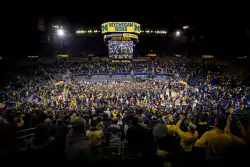
Weekly Hoops Trend
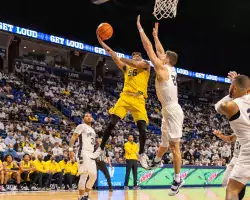
Hope you didn't watch this one.

Weekly Hoop Trends

time for another round of auto-bench debates!
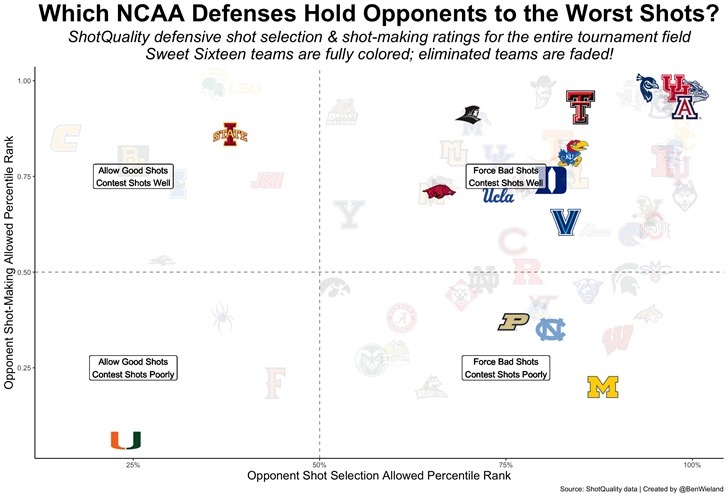
30